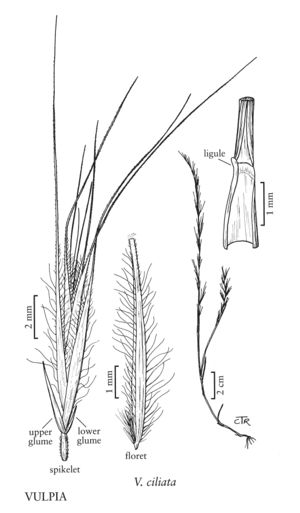Difference between revisions of "Vulpia ciliata"
FNA>Volume Importer |
imported>Volume Importer |
||
| (7 intermediate revisions by 2 users not shown) | |||
| Line 26: | Line 26: | ||
-->{{#Taxon: | -->{{#Taxon: | ||
name=Vulpia ciliata | name=Vulpia ciliata | ||
| − | |||
|authority=Dumort. | |authority=Dumort. | ||
|rank=species | |rank=species | ||
| Line 33: | Line 32: | ||
|basionyms= | |basionyms= | ||
|family=Poaceae | |family=Poaceae | ||
| + | |illustrator=Cindy Roché | ||
| + | |illustration copyright=Utah State University | ||
|distribution=Pa. | |distribution=Pa. | ||
|reference=None | |reference=None | ||
| Line 38: | Line 39: | ||
|publication year= | |publication year= | ||
|special status= | |special status= | ||
| − | |source xml=https:// | + | |source xml=https://bitbucket.org/aafc-mbb/fna-data-curation/src/200273ad09963decb8fc72550212de541d86569d/coarse_grained_fna_xml/V24/V24_651.xml |
|subfamily=Poaceae subfam. Pooideae | |subfamily=Poaceae subfam. Pooideae | ||
|tribe=Poaceae tribe Poeae | |tribe=Poaceae tribe Poeae | ||
Latest revision as of 16:24, 11 May 2021
Culms 6-45 cm, loosely tufted. Sheaths smooth, glabrous; ligules 0.2-0.5 mm; blades 3.5-10 cm long, about 0.4 mm wide, folded to involute, abaxial surfaces glabrous, adaxial surfaces puberulent. Inflorescences 3-20 cm long, 0.3-1.5 cm wide, panicles or spicate racemes, usually partially enclosed in the uppermost sheaths at maturity, with 1 branch per node, axillary pulvini absent. Spikelets 5-10.5 mm, with 4-10 florets; rachilla internodes 0.4-0.9 mm. Glumes glabrous; lower glumes 0.1-1.3 mm, less than 1/3 the length of the upper glumes; upper glumes 1.5-4 mm; lemmas 4-7.7 mm, 3(5)-veined, usually pubescent on the midvein, sometimes also on the body, rarely glabrous on both, margins ciliate, hairs to 1 mm, awns 6-15.3 mm; paleas slightly shorter than to equaling the lemmas, apices entire; anthers 0.4-0.6(1.6) mm. Caryopses 3.4-6.5 mm. 2n = 42.
Discussion
Vulpia ciliata is native to Europe, the Mediterranean area, and southwest and central Asia. It grows in open, dry habitats. It is easily distinguished from other members of the genus because of its upper glumes with broadly membranous tips that break off, making the glumes appear truncate or blunt. In the Flora region, it was known until recently only from an old ballast, dump record from Philadelphia. In May 2004, it was collected immediately north of the Odgen Bay Waterfowl Management Area, Weber County, Utah, in an upland area of the site. The source of the seeds is not known.
Selected References
None.
